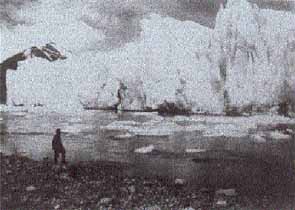|
The highest peak of this mountain chain is the Sarmiento Mount, which enormous white body comes out directly from the sea and rises amazingly into the sky. Between 1913 and 1914, the famous mountaneer made two attempts to climb this giant but the harsh weather and some orientation difficulties made it impossible for him to succeed. During the next forty years, De Agostini headed various campaigns and reconnaissance missions in which he took photographs and produced detailed descriptions of the different mountainous landscapes, glaciers and lakes that are part of the southernmost region of the Cordillera de los Andes. The succesful expeditions were many among which are the crossing of the Sierra Valdivieso to Ushuaia, the climbing of the Olivia, Carbajal and Balvedere Mounts; the exploration of the Paine massif, the Sierra de Los Baguales and the Mayo and Spegazzini fiords; the climbing of the Mayo Mount; the plane reconnaissance missions above the Cordillera; the crossing of the Hielo
|
Continental, the Argentino Lake, the Torino, Torre, Fitz Roy and San Lorenzo Peaks, the area of the San Martín Lake; the trip by boat through the Lácteo River and the crossing of the Valley of the Tranquilo River among many others. Despite his age, he finally made one of his dreams come true: in 1956-7 he guided the Italian expedition that reached the peak of the Sarmiento Mount. Father De Agostini spent his last days back in Italy and died in 1960 in the head office of the Salesians order in Turin. |
| Chapter 9 Long Live the King! ORLLIE ANTOINE |
|
|
Among so much dramatic history in Patagonia, from the time Magellan had attracted the attention of the world toward that far away place in the world, there was also room in Patagonia´s chronicles for incredible and extravagant events that bordered on the comical and even the ridiculous. Even today the history buffs of Patagonia can not help a few smiles while referring to these accounts. In this case, and like the famous case of Don Quixote, it was literature that fired up the imagination of a thirty three year old French adventurer. Orllie Antoine de Tounens story in Patagonia begins in earnest the 17 of November in 1860, when, seduced by La Auracana, an epic poem by Alonso de Ercilla, de Tounens resolves to go to Patagonia |
and proclaim himself monarch of these distant lands: So, Orllie Antoine drafted his own constitution where he fixed a hereditary monarchy as |
